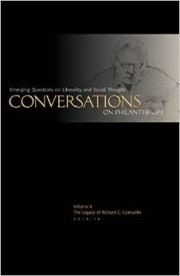Philanthropy and Investment and the Confusion of Language
Philanthropist and businessman (or businessman and philanthropist) Howard Ahmanson ponders why the current trend of blending philanthropy and investment.
I grew up believing that ‘philanthropy’ and ‘investment’ were two distinct things and not to be confused. They both serve the public, but in different ways; investment in business by [hopefully] producing worthy products at enough profit to make a good living for employees, executives, and entrepreneurs. [Milton Friedman is wrong; “maximizing shareholder value” is not the main purpose of a business. The main purpose of a business is to fulfill its calling. The Widget Company’s calling is either to make widgets, or provide in some new form the service that the widget used to perform. But a business is not ‘sustainable’ {ah the chance to use a green word!} without profit.] And non-profits serve the public by doing those things that are good and useful but where a sustainable profit cannot be had, by totally or partly relying on donations.
Ahmanson particularly points to the rise of the charitable trust industry and the emergence of new “hybrid” corporations that seek to blend business and charitable purposes. On the charitable trusts, he asks: “What are [charities] doing in the trust company business? And, fixed income annuities are not the best investments in a democracy, in which, as my Dad used to say, inflation is inevitable. What is a charity doing assuming responsibility for this?”
We might consider Ahmanson’s questions in this essay in light of an observation of Tocqueville (Democracy in America, II.4.5}:
“Formerly the sovereign lived on the revenue of its lands or on the income from taxes. Since today its needs have grown with its power, that is no longer the case. In the same circumstances in which formerly a prince established a new tax, today it has recourse to a loan. thus, little by little the state becomes a debtor to most of the wealthy, and it centralizes the greatest capital sums in its own hands.”
Observing that soon the small savings of more modest workers follow into the oversight of government, Tocqueville continues:
“This has given birth to a philanthropic institution that, if I am not mistaken, will soon become one of our greatest political institutions. Some charitable men have conceived the thought of collecting the savings of the poor man and using the income from them. In some countries these beneficent associations have remained entirely distinct from the state; but in almost all they tend visibly to be blended with it, and there are even some in which government has replaced them and has undertaken the immense task of centralizing in a single place and putting to work the daily savings of several million workers by its hands alone.
Thus the state attracts to itself the money of the wealthy by loans, and by savings banks it disposes to its liking of the money of the poor man. The wealth of the country constantly rushes to it and into its hands; it accumulates there all the more as equality of conditions becomes greater; for in a democratic nation there is only the state to inspire the confidence of particular persons, because only it appears to them to have some force and some duration.”
Ahmanson is not at all baffled by the beneficence of philanthropy, but baffled by the confused innovation of “donating” to what is sure to be non-profiting enterprise, and to call this “investing.” Ahmanson proposes that the hybridization of business and philanthropy may be a way of legally shielding entrepreneurs when an enterprise fails.
I suspect the phenomenon is also part of the outgrowth of the confusion of words endemic in our great age of deficit spending, where shuffling debt around on the deck is called “stimulus” and is presumed to yield “growth,” none of which has much to do with the generation of “profit”, a thing that is now widely regarded as a thing morally suspect and likely a sure sign of some form of injustice. Sadly, it is only out of profit that philanthropic giving can be sustained (and taxes can be paid), and to so confuse our language or moral categories is likely to prove a titanic error.
Describing human action with the right words and concepts is something that fundamentally matters. Ahmanson’s question is one we should all be pondering.




